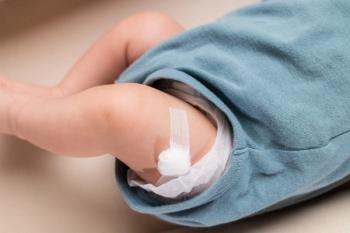
- Consultant for Pediatricians Vol 5 No 11
- Volume 5
- Issue 11
What Role for an Insulin Pump for the Very Young?
What are the indications for use of an insulin pump in veryyoung children (infants and preschoolers)?
Q: What are the indications for use of an insulin pump in very young children (infants and preschoolers)?
A: The results of the Diabetes Control and Complications Trial (DCCT)1 and the Epidemiology of Diabetes Interventions and Complications2 (EDIC) study provide the rationale for achieving strict glycemic control in all of our patients with type 1 diabetes. These studies demonstrate that intensive management reduces the incidence and progression of microvascular disease in the short term and long term as well.
In children--and in particular in the youngest subset of children (ie, infants and toddlers)--the concern has always been about safety, particularly the unknown risks of hypoglycemia on the developing brain. Older studies observed that cognitive problems are more common in children in whom diabetes was diagnosed at a younger age and that hypoglycemic brain damage is the mechanism. More recent studies suggest that hyperglycemia may be just as dangerous to young brains as hypoglycemia, but the limiting factor to diabetes treatment in infants and toddlers has always been fear of hypoglycemia.
Insulin pump therapy, in my opinion, is actually safer in this population than injection therapy for several reasons:
Large doses of long-acting insulin are avoided, with the attendant unpredictable peaks and variabilities.
Basal insulin coverage can be adjusted as needed for exercise, illness, etc.
It offers freedom from rigid, inflexible meal schedules and contents (which is particularly important with toddlers).
It improves the quality of life for parents, particularly mothers, who typically bear the greatest burden of diabetes care in the youngest patients.
Non-randomized prospective studies have clearly demonstrated that pump therapy improves diabetes control and reduces hypoglycemia risk, even in infants and toddlers,3,4 and is associated with improvements in quality of life.5 However, randomized controlled trials of pump therapy versus injection therapy in very young children have not shown the same consistent improvements.6-8 These studies show no significant improvement in hemoglobin A1c level and even slightly higher rates of non-severe hypoglycemia in the pump-treated patients. However, they also show significant improvement in quality of life in the pump groups.
What explains the discrepancy between non-randomized and randomized studies? Selection of patients is a key factor.In a real clinical practice, patients are not randomly assigned to treatment groups. The question, therefore, is not of efficacy but of effectiveness. Pump therapy is a very powerful tool in the right hands. Our guiding principle in the selection of patients has not been the ability or the inability to achieve good control with injections, nor have there been any age or socioeconomic criteria. Families must simply demonstrate a proficiency and commitment to the types of diabetes tasks that will be required for pump therapy. These include:
A history of good adherence to testing.
The ability to count carbohydrates.
An understanding of the benefits and limitations of pump therapy (eg, a pump is not a cure for diabetes, just another way to take insulin).
An understanding of the technical aspects of pump therapy (eg, the difference between basal and bolus; how to navigate controls on pump, change settings).
Adequate adult supervision and commitment to follow-up.
Ready access to a diabetes treatment team skilled and comfortable with the management of kids on pumps.
We have even found that children who have nannies or who are in daycare can do well on a pump. They do even better, in fact, than do children who are receiving injections.4
The reader is referred to 2 reviews in a recent issue devoted to insulin pump therapy.9,10
References:
REFERENCES:
1. The Diabetes Control and Complications Trial Research Group. The effect of intensive treatment of diabetes on the development and progression of long-term complications in insulin-dependent diabetes mellitus. N Engl J Med. 1993; 329:977-986.
2.Sustained effect of intensive treatment of type 1 diabetes mellitus on development and progression of diabetic nephropathy: the Epidemiology of Diabetes Interventions and Complications (EDIC) study. JAMA. 2003;290:2159-2167.
3.Ahern JA, Boland EA, Doane R, et al. Insulin pump therapy in pediatrics: a therapeutic alternative to safely lower HbA1c levels across all age groups. Pediatr Diabetes. 2002;3:10-15.
4.Weinzimer SA, Ahern JH, Doyle EA, et al. Persistence of benefits of contin-uous subcutaneous insulin unfusion in very young children with type 1 diabetes: a follow-up report. J Pediatr. 2004;114:1601-1605.
5.Sullivan-Bolyai S, Knafl K, Tamborlane W, Grey M. Patient's reflections on managing their children's diabetes with insulin pumps. J Nurs Scholarsh. 2004; 36:316-323.
6. DiMeglio LA, Potteroff TM, Boyd SR, et al. A randomized, controlled study of insulin pump therapy in diabetic preschoolers. J Pediatr. 2004;145:380-384.
7. Fox LA, Buckloh LM, Smith DS, et al. A randomized controlled trial of insulin pump therapy in young children with type 1 diabetes. Diabetes Care. 2005;28:15-19.
8. Wilson DM, Buckinham BA, Kunselman EL, et al. A two-center randomized controlled feasibility trial of insulin pump therapy in young children with diabetes. Diabetes Care. 2005;28:15-19.
9. Fisher LK. The selection of children and adolescents for treatment with continuous subcutaneous insulin infusion (CSII). Pediatr Diabetes. 2006;7 (suppl 4):11-14.
10. Weinzimer SA, Swan KL, Sikes KA, Ahern JH. Emerging evidence for the use of insulin pump therapy in infants, toddlers, and preschool-aged children with type 1 diabetes. Pediatr Diabetes. 2006;7(suppl 4):15-19.
Articles in this issue
about 19 years ago
Case in Point: Ups and Downs of Trampoline Useabout 19 years ago
What's the Opposite of Growing Pains?about 19 years ago
Oral Health:about 19 years ago
Posterior Urethral Valves in an Infantabout 19 years ago
Case In Point: Subconjunctival Hemorrhages in a Teenage Boyabout 19 years ago
Goat Bite in a 4-Year-Old Boyabout 19 years ago
Preventing Sudden Cardiac Death in Young Athletes: How Should We Screen?about 19 years ago
Photoclinic: Actinomycosis in a Young Boyabout 19 years ago
Photo Finish: Acute Dx: What Cause of Sudden Illness? rhus dermatitisNewsletter
Access practical, evidence-based guidance to support better care for our youngest patients. Join our email list for the latest clinical updates.








